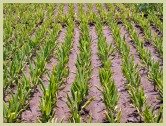Grow Your Own Cumin Plant For The
Freshest Cumin Seeds!
Thriving in sunny moderate climates, the cumin plant is a native of the Nile valley, Egypt and the Eastern Mediterranean. Today you'll find the spice being cultivated throughout the world, ranging from the Americas to Iran and Turkey, through to India, China and North Africa.
A member of the parsley family (apiaceae), cumin (Cuminum cyminum) is a smallish herbaceous annual plant which grows to a height of approx 1 ft (30 cm).
Cumin Plant History and Growing Tips

The weed-like branches and leaves of the plant are very thin and feathery and the flowers are a small, pretty pink or white colour.
And it's these short-lived flowers that after flowering produce clusters of the popular cumin seed.
Throughout its history, and still to this day, this spice is harvested by hand which takes place about 4 months after sowing.
When the plants begin to wither and the seeds are yellowish in colour the plants are cut down and thrashed in the same way as they've been done for thousands of years. Read more on the history of cumin.
They are then left to dry in the sun where they turn to a greeny brown colour and are ready for your cooking pot and numerous spice blends.
Growing Cumin Plants
Of course if you want to get the freshest seeds possible, growing your own is something to consider. And luckily it's not too difficult...
Growing the Cumin Plant From Seed...
These plants thrive in well-draining soil in a sheltered sunny spot.
- Sow the seeds indoors in plugs or pots in early spring
- After the frosts, plant out your seedlings 4 inches (10cm) apart into a prepared bed
- Alternatively, after the frosts, sow them in shallow drills directly into the ground and cover with soil or compost
- Water well in dry weather and about four months later you'll be ready to harvest. Note: Sow them fairly thickly and don't worry about the plants crowding as they'll support each other
- To harvest; cut the stalks and place 5-6 flower heads in a paper bag. Tie and hang upside down in a warm, dry place
- After 7-10 days the pods will have dried. Rub the pods between your fingers and the seeds will drop out ready for immediate use or storing in a jar out of direct sunlight
Note: I've never tried to grow black cumin, but as it also belongs to the apiaceae family, I guess it would need similar conditions to the above. Click for info on the black seeds and plant.
Links to Other Spice Plants You May Enjoy Reading About
The Super Healthy
|
The Elegant and Expensive Saffron Crocus |
Everything You Need to Know About Cloves |
Click on the buttons above to follow me on your favourite social media:
The Herb & Spice
Mix Bible
by
Jason Pitcher

Sign up to my monthly newsletter and get a
FREE Book!
Click on the buttons above to follow me on your favourite social media:










New! Comments
Have your say about what you just read! Leave me a comment in the box below.